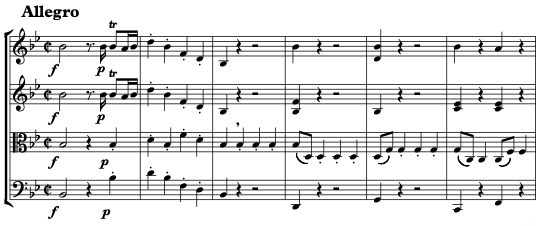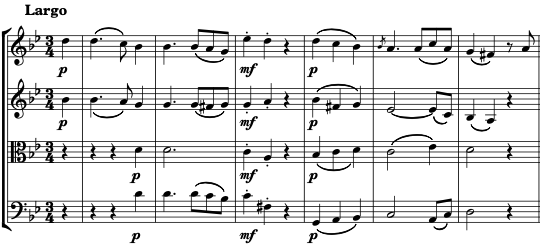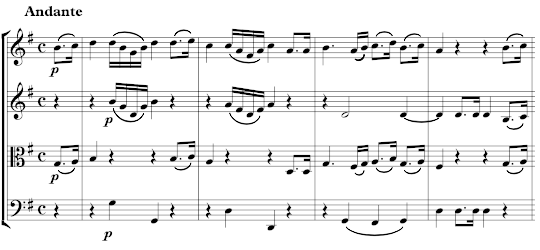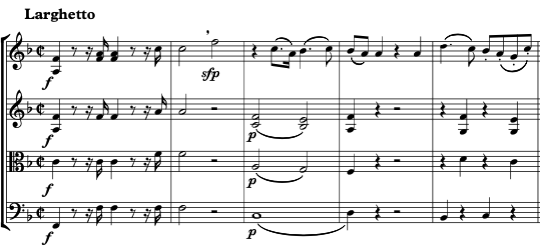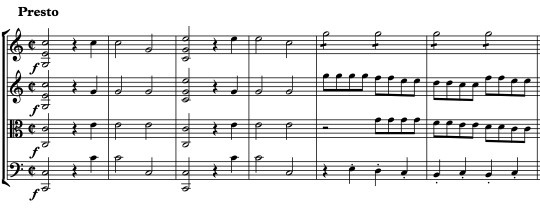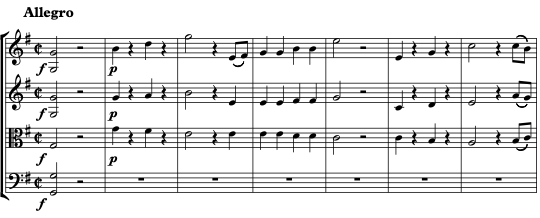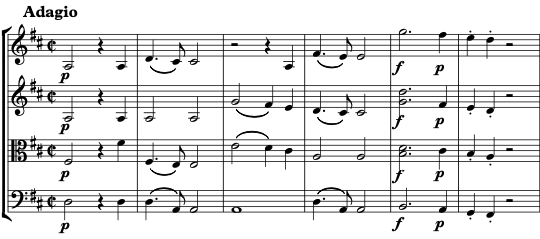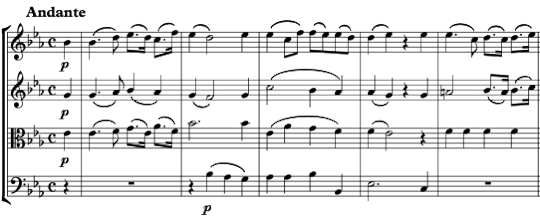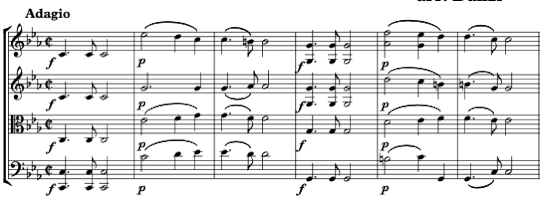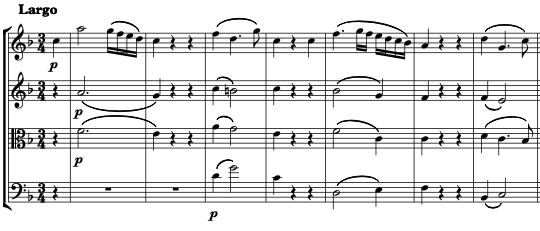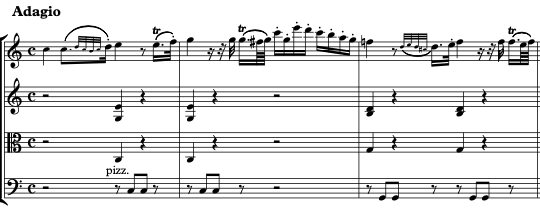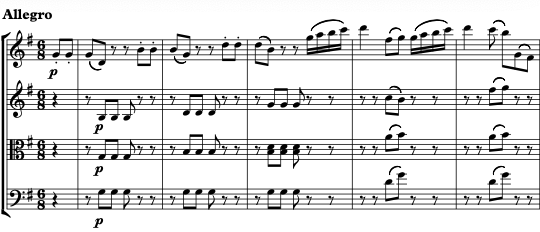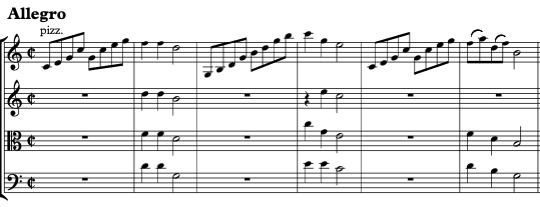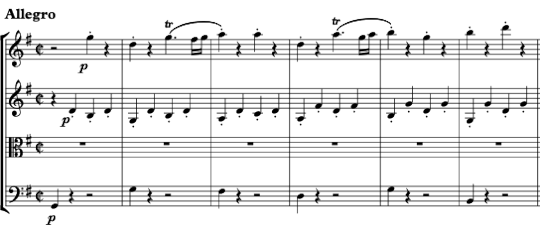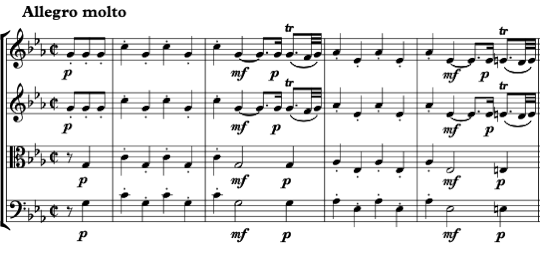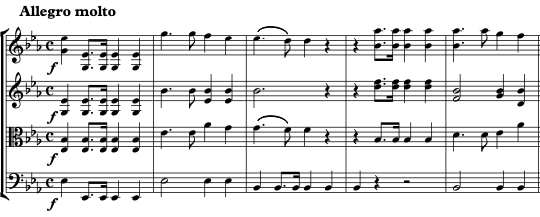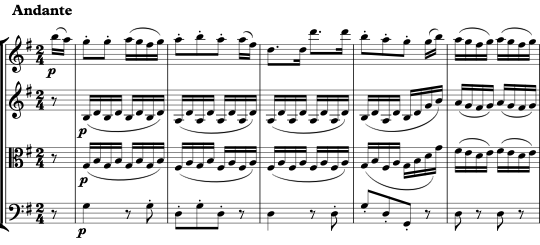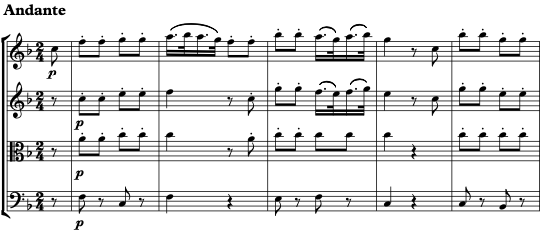composed by Mozart
Danzi, Franz Ignaz (1763-1826) was a German composer. His works are not so popular. Only his wind quintets are know among woodwind players. He revered W. A. Mozart, and arranged “Die Zauberflöte” for string quartets. A set of the part notes was published by M. Falter, Munich around 1800. His arrangement consists of 17 pieces as follows.
No.1, “Hm! Hm! Hm! Hm!”
No.2, “Zum Leiden bin ich auserkoren”
No.3, “Schnelle Füsse rascher Mut”
No.4, “Es lebe Sarastro Sarastro lebe!”
No.5, “Herr ich bin zwar Verbrecherin”
No.6, “Wenn tugend und gerechtigkeit”
No.7, “Wie? wie? wie?”
No.8, “O Isis und Osiris”
No.9, “Bald prengt den Morgen zu verkünden”
No.10, “Der, welcher wandert diese Straße voll Beschwerden”
No.11, “Tamino mein!”
No.12, “Wir wandelten durch Feuersgluten”
No.13, “Papagena! Papagena! Weibchen! Täubchen!”
No.14, “Klinget, Glockchen, klinget!”
No.15, “Pa-Pa-Pa-Papageno”
No.16, “Nur stille! stille!”
No.17, “Heil sei euch Geweihten”
The arrangement was very faithful to the original, and is valuable in that players could enjoy the wonderful music as a chamber music. We first made the transcript of the sheet music published by M. Falter, and combined them to make scores. The scores show some discrepancies, which are usual in such old music notes, and was revised to obtain unified styles and articulations. In the revising, we referred the original score by Mozart.
Danzi arranged 17 arias from Die Zauberflöte for string quartet, but some important arias were not included in his arrangements. Therefore, we created our own arrangements for those pieces. We have made a table showing which original pieces match Danzi’s arrangements and our own. Please refer to this table.
No.1, “Hm! Hm! Hm! Hm!”
No.1, “Hm! Hm! Hm! Hm!” is a quintet for Paoageno, Tamino, and three Queen’s maids. Paoageno’s mouth was locked as a punishment for lying. The maids remove the lock, and warn Paoageno not to lie. They give Tamino a magic flute, which changes sorrows to joys. They push Papageno to go to Sarastro’s temple with Tamino, and give Papageno magic bells.
No. 2 “Zum Leiden bin ich auserkoren”
No.2, “Zum Leiden bin ich auserkoren” is an aria for the Queen of the Night. She plumbs the depths of sorrow because her daughter, Pamina, was captured by Sarastro. She encourages Tamino to rescue Pamina.
No.3, “Schnelle Füsse rascher Mut”
No.3, “Schnelle Füsse rascher Mut” is an aria for Papageno and Pamina. They are running away from the castle. Papageno and Tamino find the other’s existence by the sounds of their flutes. There are four passages “sol-la-si-do-re” corresponding to Papageno, Tamino, Papageno, and Tamino. All four passages are played by violin-I in Danzi’s arrangement. We play Papageno’s part by Viola to obtain a clear image of communication between Papageno and Tamino. The Viola part note contains cue notes of Papageno’s passage for this purpose. Please try.
No.4, “Es lebe Sarastro Sarastro lebe!”
No.4, “Es lebe Sarastro Sarastro lebe!” is a short piece for Chorus. Sarastro is arriving, and people praise Sarastro for his wisdom.
No.5, “Herr ich bin zwar Verbrecherin”
No.5, “Herr ich bin zwar Verbrecherin” is a duet for Pamina and Sarastro, followed by a quartet for Monostatos, Panima, Tamino, and Sarastro. Pamina gives Sarastro the reason of her escaping and he recognizes the situation. Monostatos comes on stage with Tamino, and Sarastro punishes Monostatos.
No.6, “Wenn tugend und gerechtigkeit”
No.6, “Wenn tugend und gerechtigkeit” is a Chorus. Tamino should go through trials of wisdom to be Pamina’s husband. Tamino and Papageno are covered with bags. The Chorus exalt virtue and justice.
No.7, “Wie? wie? wie?”
No.7, “Wie? wie? wie?” is a quintet for thee Ladies, Tamino, and Papageno. The three ladies appear and terrorize Tamino and Papageno. Papageno can’t help but answer them, however, Tamino keeps quiet according to the priests. The ladies are in confusion and are sucked into an abyss.
No.8, “O Isis und Osiris”
No.8, “O Isis und Osiris” is Priests’ Chorus. The priests pray Tamino’s success.
No.9, “Bald prengt den Morgen zu verkünden”
No.9, “Bald prengt den Morgen zu verkünden” is a quartet for three boys and Pamina. Pamina is despairing because she Tamino spoke nothing to her. She has suicidal thoughts. Three boys restrain her, and tell her that Tamino loves her. In the measures from No. 40 to 42, and from No. 60 to 64, the sheet music published by M. Falter around 1800 has only accompaniment parts. The voice parts are missing. It must be some mistake. We rearranged the error parts following Danzi’s way of arrangements to restore the voice notes.
No.10, “Der, welcher wandert diese Straße voll Beschwerden”
No.10, “Der, welcher wandert diese Straße voll Beschwerden” is an aria for two armored men and Tamino. Two armored men lead in Tamino, and promise that one will be enlightened by conquering the fear of death. Tamino hears Pamina’s call from a distance. The armored men allow him to meet Pamina.
No.11, “Tamino mein!”
No.11, “Tamino mein!” is a duet for Pamina and Tamino. They come through the ordeal of fire and water through the help of the magic flute.
No.12, “Wir wandelten durch Feuersgluten”
No.12, “Wir wandelten durch Feuersgluten” is a duet for Tamino and Pamina. They pass through chambers of fire and water with the help of the magic flute. The priests celebrate them.
No.13, “Papagena! Papagena! Weibchen! Täubchen!”
No.13, “Papagena! Papagena! Weibchen! Täubchen!” is an aria for Papageno. He desperates enough to try to kill himself.
No.14, “Klinget, Glockchen, klinget!”
No.14, “Klinget, Glockchen, klinget!” is for Papageno and the three boys. The three boys stop Papageno, and urge him to play the magic bells to find Papagena.
No.15, “Pa-Pa-Pa-Papageno”
No.15, “Pa-Pa-Pa-Papageno” is a duet for Papageno and Papagena. Papagena appears and they call each other, “Pa-Pa-Pa-Pa-Pa-Pa-Papagena!” and “Pa-Pa-Pa-Pa-Pa-Pa-Papageno!”.
No.16, “Nur stille! stille!”
No.16, “Nur stille! stille!” is for Monostatos, the Queen of the Night, and the three ladies. They are going to sneak into the temple. Thunder, lightning, and tempest interrupt them, and finally they go to hell. Danzi’s arrangement ends just before the thunder.
No.17, “Heil sei euch Geweihten”
No.17, “Heil sei euch Geweihten” is Chorus. After the sings of the victory of the sun over night by Sarastro, “Die Strahlen der Sonne vertreiben die Nacht, Zernichten der Heuchler erschlichene Macht.”, the priests thank to Isis and Osiris.
The followings titles are our own arrangements.
Nr.2 “Der Vogelfänger bin ich ja”
First, let us describe a scene from the opera in which the aria is sung. In this scene, a character named Papageno appears, who is half man and half bird. He sings a song describing himself. Papageno works as a bird-catcher, catching birds to exchange them for food with the queen and her ladies. His appearance and song reflect his cheerful and carefree character. Papageno is portrayed as a contrasting character to the young prince Tamino, who he later teams up with. In the opera’s premiere, the librettist Emanuel Schikaneder played the role of Papageno, which shows his importance.
This aria is lively and cheerful, perfectly matching Papageno’s character. There is a short ascending scale of 32nd notes in the middle, which is played by a pan flute that Papageno carries and makes sounds like chirping birds.
In this arrangement, all players can enjoy playing. The melody is played not only by the first violin but also by the viola and cello. The second violin plays parts of the pan flute melody, among others.
Nr.14 “Der Hölle Rache kocht in meinem Herzen”
Nr.14 “Der Hölle Rache kocht in meinem Herzen” is an aria for the Queen of the Night. It is one of the most famous aria in opera history. It is energetic, dramatic, and beautiful. Our arrangement is faithful to the original, but the solo part is assigned to four parts for player’s pleasure.
Nr.20 “Ein Mädchen oder Weibchen wünscht Papageno sich”
Papageno and Tamino face the ordeals. Tamino is able to overcome them one by one, but Papageno struggles because he lacks the mental strength to do so. When Papageno tells Sprecher that he would be happy with just some wine, Sprecher asks if he has any other wishes. Papageno says he didn’t have any before, but then he thinks of something else he wants and starts singing a song about it. The song says that it feels good to eat and drink delicious things, but Papageno is lonely and wants a cute girl or a wife. Papageno plays a musical instrument called a “Glockenspiel” while singing. This instrument is different from the modern Glockenspiel and is a keyboard instrument that strikes metal plates.
In this arrangement, all the parts take turns playing the melody so that all the performers can enjoy it.
